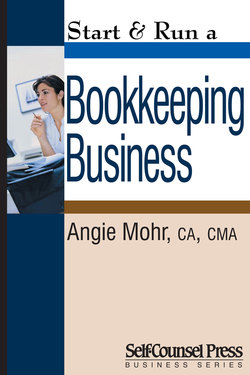Читать книгу Start & Run a Bookkeeping Business - Angie Mohr - Страница 24
На сайте Литреса книга снята с продажи.
Cash to Provide Liquidity
ОглавлениеYour next most important need for cash once you have covered your start-up expenses is to cover any projected shortfalls of cash before your practice becomes profitable. For example, if you are expecting a shortfall of $450, $295, and $75, respectively, in the first three months, you will need $820 in financing to cover that shortfall.
Many small-business owners who don’t spend time forecasting their profits end up having to cover the shortfall in inappropriate ways, such as running up balances on credit cards.
Let’s look at an example of how you would predict your revenues and expenses for your first year of operations. There are several important things to note as you prepare your own cash-flow projection.
• Keep in mind the difference between cash flows and revenue and expenses. Cash flow refers to the actual inflows and outflows of cash, whereas revenue and expenses (as reported on the income statement) can reflect items where the cash transaction hasn’t yet occurred. For example, if you sell an item today but your customer won’t pay you for 30 days, this will show up on an income statement as a revenue item, but would not show up in a cash-flow report because you haven’t yet received the money. The cash-flow projection deals only with actual inflows and outflows of money. Its purpose is to make sure that you don’t run out of money. For a fuller discussion of cash flows versus income and expenses, you may wish to refer to Financial Management 101, also published by Self-Counsel Press.
• The “Cash receipts” line reflects your estimate of the actual receipt of accounts receivable, not your revenue projections. For example, you may collect only 15 percent of your revenues in the month of sale, 63 percent the following month, 18 percent in two months, and 4 percent in three months. As you get more historical data for your business, you will be able to understand your revenue collection patterns more clearly. If you are reporting $1,250 in sales for the month of January, your cash-flow report would only show cash receipts of $187.50. Make sure when you are preparing your cash-flow projection that you take into consideration the average length of time it will take to collect your receivables.
• All cash receipts and cash payments appear on the cash-flow projection, regardless of their source. There can be a line for the purchase of capital equipment. This item would not be recorded on the income statement (it is a balance sheet item), but it is a payment of cash. Any projected purchases such as equipment or inventory should be included in your projection. The same would be true of proceeds from a new loan. If the bank lends you $25,000, it would show as a receipt of cash on the cash-flow report.
• If the closing cash balance on the cash-flow projection falls below zero at the end of any month, you will have to consider how to finance the shortfall. It is okay to have a net cash outflow in any particular month (as in the month of April in the example) as long as there is a cumulative cash surplus going into the month. This would roughly translate to a positive projected balance in the business bank account, which would be able to absorb any shortfall up to that balance. It is only when the cumulative balance drops below zero (i.e., you have no money in the bank account) that you have to have other financing in place.
Once you have determined how much financing you will need for your bookkeeping business, it’s time to make sure that your personal finances are in good order before you approach lenders and investors.
